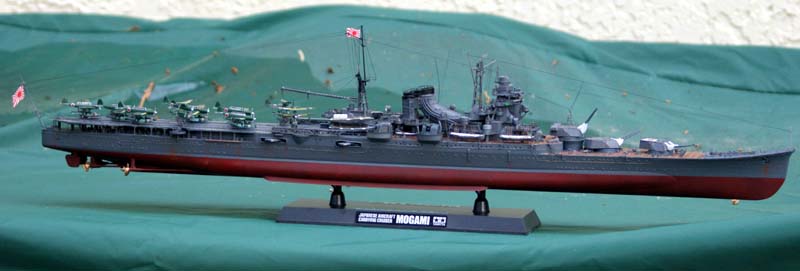by Robert Apfelzweig

1/350 IJN Mogami (Tamiya)

Shortly after completing my recent Aoshima IJN heavy cruiser Takao, I resumed work on this model of the Mogami, in her mid-1943 appearance after being converted to an aircraft-carrying heavy cruiser following severe damage suffered at the hands of U.S. Navy Dauntless divebombers in the Battle of Midway (in which her sistership the Mikuma was sunk). The kit, which is very finely detailed and extremely sturdy, represents Tamiya's re-entry into the world of contemporary 1:350 plastic kits of World War II naval subjects. It was lavishly completed with Lionroar's exquisite and extensive photoetch set, which includes brass gun barrels for the 8-in. and 5-in. gun batteries. In the past, I have complained about the fragility of Lionroar photoetch sets because of the thinness of the brass sheets used, but in this set the brass is thicker and supplemented by frets of laser-etched steel. The steel, which is used for railings, ladders, boat davits, the latticeworks for the forward cutter boats and various mast sections, is stiff but bendable (with patience -- it's much more springy than brass). The entire flight deck is brass in a three-piece "sandwich" with brass top and bottom sheets and a plastic center to add thickness. The plastic support poles from the original Tamiya plastic deck must be cut off and transplanted onto the bottom of the sandwich. The triple 25-mm light anti-aircraft guns still have barrels that are too 2-dimensional, but at least all these parts are thicker now and less prone to crushing. The plastic Tamiya triple 25mm guns are finely crafted and could be usable in place of the individual Lionroar brass barrels, though they seem a little overscale. Tamiya provides its own steel photoetch fret, but the Lionroar equivalents included in their set are more finely crafted. Indeed, the only brass parts from the Lionroar kit I chose not to use (aside from a welcome number of extra parts) were the boat oars, which were strangely oversized (much too wide); I had some spares from a Gold Medal Models Takao set that I used instead. The Lionroar set did not include the transverse brass strips for the linoleum decks; I had a number of these left over from my Takao build and when I ran out of them I made the rest from unpainted brass railing segments.
I mentioned how sturdy the Mogami hull is; seven thick transverse struts are used (separately for the full hull or waterline versions offered by Tamiya) to stabilize the hull (Trumpeter! Take note!) and the decks are bolted to plastic tubular supports in the hull; the display stand bolts into the hull from underneath. Tamiya's turret design utilizes internal polyethylene cylinders (the same type that permit the turrets, torpedo tubes and 5-in. dual mounts to be inserted into their positions and still rotate easily, but not fall out) for the 8-in. gun barrels, with pegs behind the blast bags so that the gun barrels (in any of three different elevation positions) can be inserted to show any of those elevation levels, but in this way they are fixed and cannot be elevated. The four twin 5-in. gun mounts, however, are designed to both rotate and elevate the guns.
The Mogami, originally built as a light cruiser with five triple 6-in. gun turrets, was rebuilt as a heavy cruiser with ten 8-in. guns in 1939 and again at Sasebo following the Battle of Midway, having both rear turrets replaced by the flight deck, but it was only intended to carry floatplanes (there was no elevator or hangar). Eleven are provided in the kit, but my internet sources told me that only eight were usually carried at one time (five Aichi E13A "Jakes" and three Mitsubishi F1M "Pete" biplanes. I chose to show nine aircraft -- these make the flight deck crowded enough. The aircraft were moved on carriages along trolley tracks on the deck to the two catapults, where the boat/aircraft crane would place them on the catapult and recover them from the sea. Japan desperately needed reconnaissance aircraft after losing four of their best aircraft carriers at Midway, but the Mogami (and the larger battleship conversions, the Ise and Hyuga) was never especially effective in her new dual role, and she was lost following the Battle of Surigao Strait on October 25, 1944 as part of Admiral Nishimura's central force that included the similarly ill-fated battleships Fuso and Yamashiro.
I should point out that Tamiya's Mogami represents the ship as rebuilt in May 1943; by the time she was sunk, the flight deck had been extended at the stern and additional triple and single 25-mm machine guns had been added throughout her length.
The model is painted with Tamiya spray Sasebo gray (TS-67) and hull red; the forecastle and gun decks are WEM Colourcoats IJN linoleum. The Tamiya kit has an extensive decal set but the flags are paper and must be cut out and the two halves glued together. Lionroar's photoetch set includes a separate fret of porthole scuttles (over twice the number needed), which were tediously glued along both sides of the hull to simulate the covers welded over the portholes in Sasebo to provide additional resistance to flooding from battle damage.
This build of the Mogami turned out so well that I'm looking forward to a future project of Tamiya's new IJN heavy cruiser Tone.
